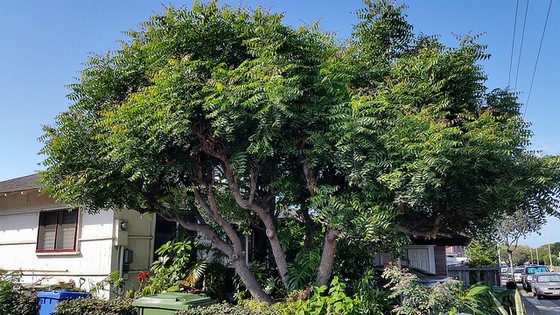The Neem Tree - Azadirachta Indica
Growing Neem - The Neem Tree's Many Uses And Benefits
The neem tree has lately been called the world's most researched tree.
That is not surprising. Just look at the many medicinal and other uses that all parts of this fascinating tree have.
 A large neem tree. Photo: Wendy Cutler
A large neem tree. Photo: Wendy CutlerNeem has been used traditionally for many centuries. In India it is known as "the village pharmacy". But neem is still relatively unknown in the Western world.
However, word about neem is slowly spreading, and so are neem products: neem oil, neem capsules, neem soap, shampoo and toothpaste, dried neem leaf and more.
As for other medicinal plants or herbs you can find many recipes for home remedies using neem.
So naturally people are getting curious... Some would like to grow their own neem plant. Some are wondering, "What is this neem tree? What can I use it for? What are the benefits of neem?"
Let's have a look: here is a profile of the neem tree. Below you find links to more information. Read more about its history, about how to grow it, and about its many uses.
Discover The Neem Tree
Azadirachta indica - That's the botanical name for neem. Indica gives away the tree's origin, India.
The whole name, though of course latinized, comes from the Persian language Farsi:
- Azad means free
- Dirakht means tree
- i-Hind means of Indian origin
So the botanical name translates into: "The Free Tree Of India"
Another common name for neem is Margosa. (It has many more names.)
Neem belongs to the botanical family Meliaceae. That means it is related to the mahogany tree. (The Meliaceae family is also called the mahogany family)
Neem is a very attractive, fast growing and evergreen tree.
It has a straight trunk and the tree can reach a height of 30 metres and more, though 15 to 20 metres is the average. The bark is hard, rough and scaly, fissured even in young trees. It's often brown, but in older trees it can be pale or greyish-black.
Spreading branches with dark green leaves form a dense, round canopy, up to 20 metres across. (It makes a very good shade tree).
Leaves are alternate (not opposite each other along the branches) and consist of several leaflets with serrated edges. You can see the leaves in the banner of this site.
The flowers are large clusters of up to 250 individual white blooms. The whole cluster can be quite large, but the individual flowers are only a few millimetres across. They look inconspicuous, however, the scent is just heavenly. You can smell a flowering neem tree from miles away.
The olive like, edible fruit is oval to round and thin skinned. (Edible does not mean tasty.) It is green initially and turns yellow when ripe. Every fruit contains one, and sometimes two or three, seeds.
Neem is easy to grow in a wide range of temperatures and conditions, and the tree can live for 150 to 200 years.
All parts of the neem plant have been used for many centuries in India. From India the tree and the knowledge about its many uses and benefits has spread. Today neem grows in many countries across the world, and a wide range of neem products is available commercially.
Find out more, and you will soon see why the neem tree is popularly called "wonder tree":